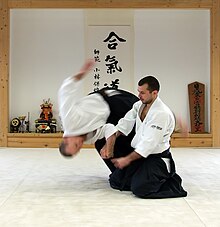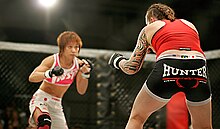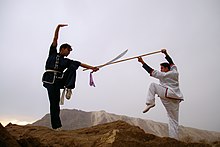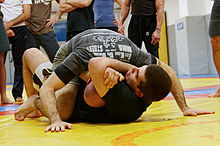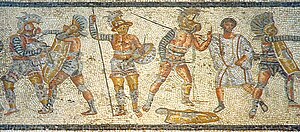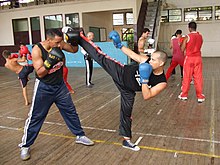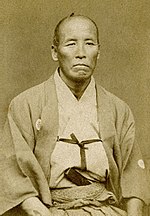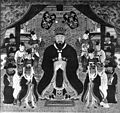Portal:Martial arts
The Martial Arts Portal

Martial arts are codified systems and traditions of combat practiced for a number of reasons such as self-defence; military and law enforcement applications; competition; physical, mental, and spiritual development; entertainment; and the preservation of a nation's intangible cultural heritage. (Full article...)
Although the earliest evidence of martial arts goes back millennia, the true roots are difficult to reconstruct. Inherent patterns of human aggression which inspire practice of mock combat (in particular wrestling) and optimization of serious close combat as cultural universals are doubtlessly inherited from the pre-human stage and were made into an "art" from the earliest emergence of that concept. Indeed, many universals of martial art are fixed by the specifics of human physiology and not dependent on a specific tradition or era.
Specific martial traditions become identifiable in Classical Antiquity, with disciplines such as shuai jiao, Greek wrestling or those described in the Indian epics or the Spring and Autumn Annals of China. (Full article...)
Selected articles
Selected biography
After the fall of the Tokugawa shogunate Sakakibara was instrumental in preserving traditional Japanese sword techniques in the early Meiji Era. Despite his eventual opposition to the practice of sword fighting for sport, his work during this period laid the foundations for the modern sport of kendo. In his later years he taught a number of noted martial artists, and was honoured by the All Japan Kendo Federation after his death. (Full article...)
Selected entertainment
Mortal Kombat II is a fighting game originally produced by Midway for the arcades in 1993. It was ported to multiple home systems, including MS-DOS, Amiga, Game Boy, Game Gear, Sega Genesis, 32X, Sega Saturn, Super Nintendo Entertainment System, and PlayStation only in Japan, mostly in licensed versions developed by Probe Software (later renamed to Probe Entertainment for some ports of the game) and Sculptured Software and published by Acclaim Entertainment (currently distributed by Warner Bros. Interactive Entertainment).
It is the second main installment in the Mortal Kombat franchise and a sequel to 1992's Mortal Kombat, improving the gameplay and expanding the mythos of the original Mortal Kombat, introducing more varied finishing moves (including several Fatalities per character and new finishers, such as Babality and Friendship) and several iconic characters, such as Kitana, Mileena, Kung Lao, the hidden character Noob Saibot, and the series' recurring villain, Shao Kahn. The game's plot continues from the first game, featuring the next Mortal Kombat tournament set in the otherdimensional realm of Outworld, with the Outworld and Earthrealm representatives fighting each other on their way to challenge the evil emperor Shao Kahn.
The game was an unprecedented commercial success and was acclaimed by most critics, receiving many annual awards and being featured in various top lists in the years and decades to come, and also caused a major video game controversy due to the series' continuous depiction of graphic violence. It spawned a spin-off game, Mortal Kombat: Shaolin Monks, had the greatest influence on the 2011 soft reboot game Mortal Kombat, and inspired numerous video game clones. Mortal Kombat II is often cited as one of the best video games ever made.
A sequel, Mortal Kombat 3, was released in 1995.
Sports portals
Selected image
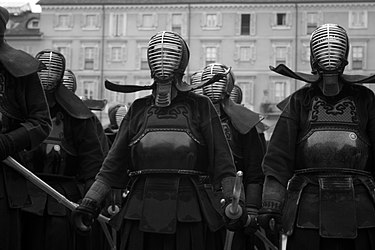 |
Kendo (剣道, Kendō, lit. 'sword way', 'sword path' or 'way of the sword') is a modern Japanese martial art, descended from kenjutsu (one of the old Japanese martial arts, swordsmanship), that uses bamboo swords (shinai) as well as protective armor (bōgu). It began as samurai warriors' customary swordsmanship exercises, and today it is widely practiced within Japan and has spread to many other nations across the world. (Full article...)
General images -
Selected quote
Topics
- Regional origin - China - Europe - India - Indonesia - Japan - Korea - Philippines
- Unarmed techniques - Chokehold - Clinch - Footwork - Elbow strike - Headbutt - Hold - Kick - Knee strike - Joint lock - Punch - Sweep - Takedown - Throw
- Weapons - Archery - Duel - Knife fighting - Melee weapons - Shooting - Stick-fighting - Swordsmanship
- Training - Kata - Practice weapon - Punching bag - Pushing hands - Randori - Sparring
- Striking - Boxing - Capoeira - Karate - Kickboxing - Muay Thai - Lethwei - Sanshou - Savate - Taekwondo - Vovinam
- Internal - Aikido - Aikijutsu - Baguazhang - Tai chi - Xing Yi Quan
- Full contact / Combat sports - Professional boxing - Professional kickboxing - Knockdown karate - Mixed martial arts - Pankration - Submission wrestling
- Self-defense / Combatives - Arnis - Bartitsu - Hapkido - Kajukenbo - Krav Maga - MCMAP - Pencak Silat - Systema - Wing Chun - Legal aspects
- Eclectic / Hybrids - American Kenpo - Chun Kuk Do - Jeet Kune Do - Shooto - Shorinji Kempo - Unifight
Categories
Things you can do
See the list on the right of Martial art related projects who organise work on these articles. You can also add your self to the list of Wikipedians by martial art
Talk page tagging
If you come across a martial arts related article, adding the project template {{WikiProject Martial arts}} to the talk page will help identify them for improvement and linking to related articles. For Boxing, Fencing, Mixed martial arts and Sumo. Use {{WikiProject Boxing}}, {{WikiProject Fencing}}, {{WikiProject Mixed martial arts}} and {{WikiProject Sumo}} respectively.
- Assessment
- If possible please assess articles you tag using guidelines (Boxing, Mixed martial arts and Sumo).
Deletions
Monitor and contribute to deletion debates (Boxing).
Find images
Wikipedia requested images of martial artists, mixed martial artists and boxers.
Associated Wikimedia
The following Wikimedia Foundation sister projects provide more on this subject:
-
Commons
Free media repository -
Wikibooks
Free textbooks and manuals -
Wikidata
Free knowledge base -
Wikinews
Free-content news -
Wikiquote
Collection of quotations -
Wikisource
Free-content library -
Wikiversity
Free learning tools -
Wikivoyage
Free travel guide -
Wiktionary
Dictionary and thesaurus



